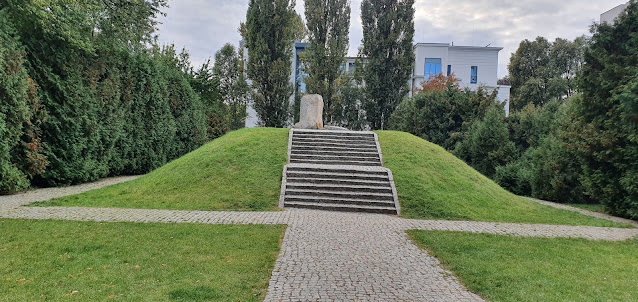The Killing Machine and Undaunted Courage
 |
| The Judenrampe |
 |
| Unending Ruins of Prisoner Barracks |
But it did. We now come to Krakow and visit one Oskar Schindler. Schindler, originally an ethnic German from Czechoslovakia, is a member of the Nazi party and an Abwehr (German Military Intelligence) agent, and has come to Krakow with the advance Wehrmacht (German Army) columns to collect intelligence. He acquires an enamelware factory among other things and builds a fortune.
 |
| Schindler's Office |
What made him do it? In a 1964 interview (below timestamp 1:07:30) with German television, Schindler says: "The persecution of Jews under the general government in Poland meant that we could see horror emerging gradually in many ways. In 1939 they were forced to wear Jewish stars and people were herded and shut up into ghettos. Then in the years '41 and '42 there was plenty of public evidence of pure sadism. With people behaving like pigs I felt the Jews were being destroyed... I had to help them. There was no choice."
 |
| Site of the Mila 18 Bunker |
This bunker was made famous by Leon Uris in his novel with the same name, Mila 18. A 2001 movie named Uprising, starring Leelee Sobieski, tells their story.
The Nazi occupation of Europe was one of the darker periods in the history of the planet. It is said that the Japanese were more cruel, but not as meticulous record keepers as the Nazis. One hopes that the world just does not keep watching as atrocities pile up as they did in the 1930s and 40s.
A few notes for travelers:
- If you are planning to visit Auschwitz - Birkenau, the best place to start is from Krakow, by booking a guided bus tour.
- For travelers that want to explore by themselves, you must first book a time slot to enter the camp. Unguided tours are available only after 3pm. Slots get booked in advance. That said, you can go up to the window and get a slot for the late afternoon. You can easily spend 2-3 hours here depending on your level of interest. Please note camp opening times change in winter.
- At the Krakow main bus station behind the Krakow Glowny (Central) railway station, you can book a bus to the Auschwitz museum stop. It takes about 75 minutes, but sadly, there are no directions posted at this stop - you have to use Google maps. If you search for the Auschwitz concentration camp, it takes you directly to Birkenau, so instead, search for Arbeit Macht Frei sign.
- Auschwitz and Birkenau are two different camps separated by ~2Km and there's a free shuttle that runs between them.
- Any bag larger than a small purse must be stored in a locker at Auschwitz but not at Birkenau. It costs 5 Polish Zlotys, or tokens which are available in the book store at the entrance.
- It is best to book a roundtrip bus fare online - if you go in the afternoon, just book the last bus coming back (bus operator is Lajkonik). You cannot do this at the Krakow bus station.
- Ubers are easily available to get back.
- Schindler's factory in Krakow is easy to find and a tram stop is close by. A ticket must be purchased to enter.
- If you Google Mila 18 in Warsaw, you will actually get to a Soviet style apartment block. The old Mila 18 is about 1Km away from this. Instead search for Bunkier Anielewicza in Google maps.
- You can pay by credit cards everywhere and for everything, including toilets. Only place where I used cash was for the locker rent and a farmer's market in my entire 7 day stay in Poland.
- The famous director Roman Polanski was in the Warsaw Ghetto as a child and smuggled out of there to the US.
- Poland is quite chilly in late September





Comments
Post a Comment